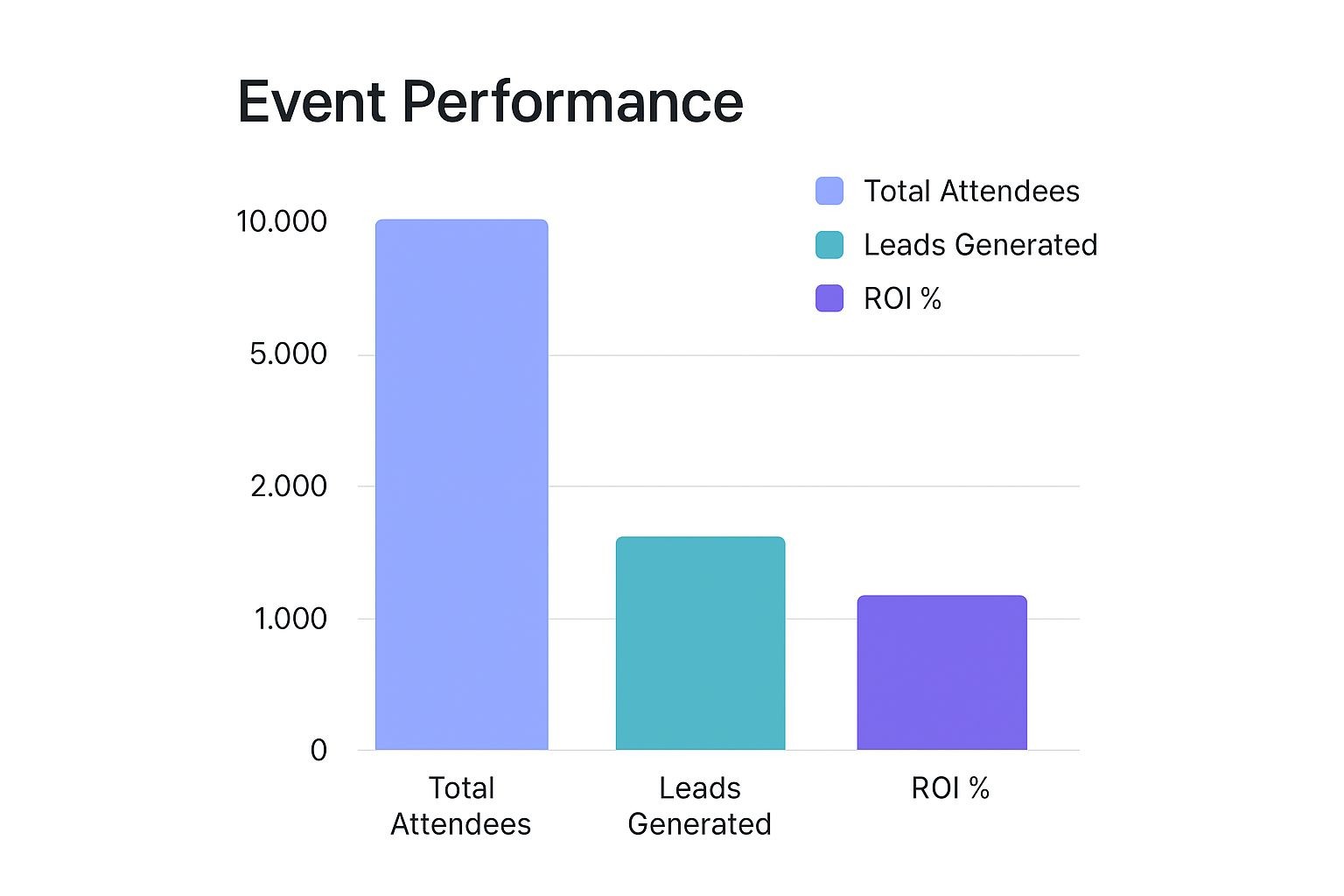Ever tried to justify your event budget with nothing but ticket sales? It feels a little hollow, doesn't it? If you've struggled to prove your event’s real impact beyond a simple revenue-minus-cost calculation, you're definitely not alone. The secret to measuring event ROI like a pro is to think bigger about what "return" actually means.
Why Old Event ROI Formulas Are Holding You Back
For years, the standard way to measure event ROI was painfully simple: subtract total costs from total revenue. It gives you a clean number, sure, but it completely misses the full story of your event's impact. That’s like judging a blockbuster movie only by its opening weekend box office, ignoring the rave reviews, audience buzz, and cultural ripple effect that follows.
This old-school model overlooks the incredible, non-financial value that events create. It just doesn't account for the crucial elements that build long-term business health.
Moving Beyond Simple Math
To paint a more compelling and, frankly, more accurate picture of your event's success, you have to look at a much broader set of outcomes. We think of it as collecting all the essential puzzle pieces.
A modern framework for measuring event ROI includes things like:
- Brand Lift: How did the event change the way attendees see your brand? A positive shift here can drive future sales and build serious trust.
- Lead Quality: It’s never just about the number of leads; it’s about their quality. A great event can deliver highly qualified leads who are practically begging to convert.
- Customer Loyalty: Events are fantastic for strengthening relationships with the customers you already have. This directly boosts retention and customer lifetime value (CLTV).
- Social Media Buzz: All that chatter happening online about your event? That’s free marketing and a powerful sign that your brand is relevant.
These so-called "intangible" benefits are often where the real gold is hidden. An attendee who turns into a brand evangelist after an amazing event experience can generate way more long-term revenue than a dozen one-off ticket sales.
The central challenge in measuring event ROI at global events lies in capturing the full, multifaceted impact beyond traditional financial metrics. In an interconnected world, conventional measures fail to fully encapsulate the benefits. You can read more about the complexities of global event measurement on livegroup.co.uk.
The Problem with a Narrow Focus
When you stick to a purely financial ROI formula, you don't just undervalue your event - you risk making some pretty bad strategic decisions. If your only goal is to maximize ticket revenue, you might be tempted to cut corners on the attendee experience, networking sessions, or top-tier content. You know, the very things that create that lasting value in the first place.
This narrow-minded approach is especially damaging for events that aren't even meant to be profit centers. Think about community meetups, user conferences, or product launch events. For these, success is measured in engagement, adoption, and pure excitement - not ticket revenue.
By building a better, more holistic measurement framework, you can finally prove the immense value these initiatives bring to the table.
Defining What Event Success Actually Looks Like

You can't hit a target you haven't defined. We've seen it happen countless times: the single most important step in measuring event ROI is often overlooked. It happens long before you book a single vendor or send the first invitation: setting clear, measurable objectives.
Without this foundation, you’re essentially flying blind, hoping for a good outcome without knowing what that even means. This is where we need to move past vague, unhelpful goals.
Sure, saying you want to "increase brand awareness" sounds good in a meeting, but it’s not a business objective. How will you measure it? What specific action do you want people to take? Getting specific is the only way to build a measurement strategy that holds up to scrutiny.
From Vague Goals to Concrete KPIs
The trick is to connect every event goal to a Key Performance Indicator (KPI). A KPI is a specific, trackable metric that tells you whether you’re actually succeeding. Think of it as creating a "Metrics Map" where every activity is linked to a measurable result.
Let’s translate some common, fuzzy goals into sharp, actionable KPIs we've seen work in the past:
- Instead of: "Boost brand awareness."
- Try: "Achieve 500 new social media followers during the event week and a 25% increase in website traffic from new users."
- Instead of: "Generate more leads."
- Try: "Acquire 75 Sales-Qualified Leads (SQLs), defined as attendees who visited our product demo booth and booked a follow-up meeting."
- Instead of: "Improve customer happiness."
- Try: "Achieve a post-event Net Promoter Score (NPS) of +50 from current customers and secure 10 video testimonials on-site."
This level of detail is absolutely critical. It transforms your event from a simple line-item expense into a strategic investment with a clear purpose. If you're looking for more inspiration on setting up for success, our guide on corporate event planning tips is a great resource.
Aligning Event Goals with Business Objectives
Your event goals can't exist in a vacuum; they have to directly support the broader objectives of your business. If your company’s primary focus this quarter is breaking into a new market, then your event’s main goal might be generating leads within that specific geographic or industry vertical.
Your event's purpose is to act as a catalyst for a larger business outcome. If you can’t draw a straight line from your event activities to a core business goal, it’s time to rethink your strategy.
For instance, say your company wants to reduce customer churn by 10% this year. A user conference suddenly becomes a powerful tool for that exact purpose. The primary objective isn't just ticket sales; it's retention.
Success, in this case, would be measured by comparing the post-event renewal rate of attendees versus non-attendees. When you frame your event goals this way, you create a powerful narrative that justifies the investment to any department, from finance to the C-suite. This focused approach ensures every dollar you spend is working toward a meaningful business result.
Tracking the Financial Metrics That Matter
While a modern take on event ROI certainly looks beyond just dollars and cents, the financial performance remains the bedrock of your event's success story. Let's be honest: these are the numbers that leadership and finance teams understand instantly. They provide a clean, hard measure of your event's impact.
Getting these calculations right isn't just important; it's non-negotiable.
The Foundational Financial Formulas
Before we get into the weeds, let's talk about the core metrics. Think of these as the primary colors of your event's financial painting - everything else is built on them. At its simplest, financial success boils down to a few key numbers. Each tells a slightly different part of the story, but together, they give you a complete picture.
We've put together a quick table that breaks down the essentials. These are the metrics you'll want to have at your fingertips for any post-event debrief.
Essential Financial Metrics for Event ROI
This table covers the key financial metrics, their formulas, and what they actually tell you about your event's performance.
| Metric | How to Calculate It | What It Measures |
|---|---|---|
| Gross Revenue | Total of all income sources (ticket sales, sponsorships, merch, etc.) | The total amount of money your event generated before any costs are deducted. |
| Net Revenue | Gross Revenue - Direct Event Costs | A clearer picture of profitability by accounting for major expenses like venue, catering, and marketing. |
| The Core ROI Formula | (Net Revenue / Total Event Costs) x 100 | A percentage that represents the direct financial return for every dollar you spent. |
| Cost Per Attendee | Total Event Costs / Number of Attendees | The average investment required to bring one person to your event. |
These formulas are your starting point, giving you that critical, top-line view of how things went from a purely financial perspective.
A 5:1 ratio is often thrown around as a strong benchmark for event ROI, meaning you generated $5 in value for every $1 invested. But honestly, what's "good" completely depends on your event goals and industry. A brand awareness event might have a lower financial ROI but smash its other goals.
This infographic gives a simple, visual take on how key outcomes like attendees, leads, and ROI can be tracked for a quick performance snapshot.

As you can see, a high attendee count can directly fuel your lead generation, which in turn drives a positive ROI. It's all connected.
Accounting for All Costs and Revenue Streams
Accuracy is everything here. On the revenue side, you need to be obsessive about tracking every single source of income. This isn't just about final ticket sales; it includes tiered pricing, complex sponsorship packages, and any a-la-carte add-ons.
On the flip side, you have to be just as meticulous with your costs. It’s easy to remember the big-ticket items like the venue rental and A/V gear. But what about the indirect costs? Things like staff salaries for the time spent on planning or a portion of your marketing team's overhead. Forgetting these "hidden" expenses will seriously inflate your final ROI number, giving you a false sense of success.
And of course, all of this hinges on having a firm grasp of your attendance numbers, since they directly impact both your revenue and your costs. If you need a refresher, we've got a whole guide on the best ways for tracking attendance at events.
The real magic happens when you use this financial data throughout the event lifecycle - not just in a post-mortem report. It allows you to make smarter, data-backed decisions on everything from ticket pricing to how you’ll budget for your next event.
Measuring Your Return on Relationships
A sold-out venue is great, but let's be honest, financial metrics only tell half the story. The truly memorable events - the ones that stick with people - are the ones that build real connections. They turn casual attendees into genuine brand fans.
This is where we need to look beyond the standard Return on Investment (ROI) and embrace something just as powerful: Return on Relationships (ROR).
While ROI is busy crunching the numbers on direct financial gains, ROR measures the softer, more human side of things. It’s all about the emotional impact and community growth that really drives long-term success. ROR asks the important questions: Did we build loyalty? Did we create a buzz? Did people leave feeling connected to our brand and, just as importantly, to each other? Answering these is the key to understanding your event’s true value.
How to Quantify Brand Sentiment
Putting a number on "feelings" might sound a bit abstract, but it's completely doable if you know where to look. Your goal is to get a clear picture of the sentiment surrounding your event, both as it's happening and in the days that follow.
A super effective, and simple, tool for this is the Net Promoter Score (NPS) survey. Just by asking attendees, "How likely are you to recommend this event to a friend or colleague?" you get a solid numerical benchmark for satisfaction.
Anything above 30 is considered good, and if you hit 50 or more, you're in excellent territory.
Post-event feedback forms are also goldmines of information. But you have to go beyond the generic questions. Ask things that dig a little deeper:
- Which session had the biggest impact on you, and why?
- Describe the event atmosphere in three words.
- Did you make any valuable new connections?
The answers you get here are pure qualitative data, revealing the genuine emotional pulse of your event.
The old way of measuring event success purely on ROI is shifting. In today's experience-focused world, ROR is becoming just as critical. While ROI tracks sales, ROR is all about the emotional connection, brand loyalty, and post-event chatter, measured through things like NPS and social shares. You can discover more insights about mastering events and this evolving perspective.
Tracking Audience Engagement and Community Growth
A strong ROR almost always leads to a more engaged, vibrant community. The connections people make at your event shouldn't just fizzle out when the lights come up. They should be the spark that starts a much longer conversation.
Social media listening is a fantastic way to keep your finger on this pulse. Keep an eye on your event hashtag, brand mentions, and any related keywords to see what people are saying online. Are they sharing photos? Tagging speakers and new friends? A flood of positive user-generated content is one of the clearest signs you've knocked it out of the park.
At the end of the day, a healthy Return on Relationships directly feeds your long-term ROI. Think about it: a happy, engaged attendee is far more likely to become a loyal customer with a high lifetime value. They become your best marketers, spreading the kind of authentic, positive word-of-mouth that no amount of ad spend can buy. This is a crucial piece of the puzzle when you want to boost your event marketing ROI with proven strategies that keep delivering value long after the event wraps up.
Using Technology for Smarter Event Measurement

Let's be honest. Trying to track every single metric we've talked about using manual spreadsheets is a recipe for burnout. Even worse, it's a surefire way to end up with inaccurate data.
Technology is your best friend when it comes to measuring ROI. The right tools automate the grunt work, freeing you up to focus on strategy. They don't just collect data; they connect the dots for you, revealing the story behind the numbers.
A solid event tech stack doesn't just sit there - it creates a seamless flow of information between systems. It all starts with your registration platform, flows through your CRM, and connects to your post-event survey tools. When these systems are all talking to each other, you get a complete, 360-degree view of your attendee's journey and its real impact on the business.
Building Your Event Tech Stack
The specific tools you choose will depend on your unique needs, but a powerful stack for measuring event ROI typically has a few core components. Each one plays a critical role in capturing the data you need to prove your event's worth.
Your main goal here is to automate data collection wherever you can. This not only saves you a ton of time but also dramatically cuts down on the human error that can completely throw off your ROI calculations.
Here are the essential building blocks we recommend:
- Event Management Platform: Think of this as your mission control. It handles registration, ticketing, and sometimes even the virtual event space itself. It’s your primary source for attendee numbers and initial revenue data. For a real-world example of a dedicated event tech solution, you might look at platforms like Eventhook.
- Customer Relationship Management (CRM): Connecting your event platform to your CRM is absolutely non-negotiable. This is the link that allows you to see how an event influences the entire sales cycle, from a new lead turning into a hot prospect and eventually a closed deal.
- Survey and Feedback Tools: To get a handle on metrics like ROR and brand sentiment, you need dedicated tools for sending out NPS surveys and detailed feedback forms. We always look for options that allow for easy segmentation and analysis.
- Analytics Dashboards: These tools are lifesavers. They pull data from all your different sources into one visual dashboard. This makes it so much easier to spot trends and share key performance indicators (KPIs) with stakeholders without drowning them in spreadsheets.
When it comes to measuring event ROI, technology's job is to give you a single source of truth. By integrating your tools, you tear down the data silos and create a clear, traceable line from a simple event registration all the way to long-term customer value.
Capturing Pre-Event Attendee Intent
One of the most powerful - and most often overlooked - data points you can track is attendee intent. Knowing who is genuinely planning to show up before your event even starts is a total game-changer for accurate ROI measurement.
This is exactly where our service fits into the picture.
When someone clicks "Add to Calendar," they're sending a much stronger signal of commitment than just registering. It's a higher level of intent. By tracking these calendar additions, you gain a powerful leading indicator of actual attendance.
This early data helps you:
- Forecast Attendance More Accurately: Your attendance projections suddenly become much more reliable than just registration numbers. This helps with everything from ordering the right amount of food to ensuring you have enough server capacity for a virtual event.
- Manage Resources Effectively: You can allocate your budget and team's time based on a much more realistic picture of who will actually be there.
- Strengthen Your ROI Calculation: This pre-event engagement metric adds a crucial layer of data, making your final analysis more robust and credible.
Taking this proactive approach gives you a massive head start on measurement, ensuring your entire ROI strategy is built on a foundation of stronger, more predictive data from the very beginning.
Got questions about measuring event ROI? You're not alone. After you've wrapped your head around the formulas and strategies, some real-world sticking points always seem to pop up.
Let's walk through some of the most common questions we hear from event organizers.
What Is a Good Event ROI?
This is the million-dollar question, isn't it? And the honest, experienced answer is: it completely depends on your event's goals.
It's tempting to chase a specific number. You'll often hear a 5:1 ratio (that's $5 in revenue for every $1 spent) thrown around as the gold standard for sales-focused events. But that's a narrow view of success.
Think about it this way: what if you run a customer appreciation event? The books might show a negative financial ROI, but if you see a 20% drop in churn among the customers who attended, that's a massive win. Or maybe you're launching a new brand. Your goal isn't immediate sales, but media mentions and social chatter. Success there is measured in impressions and reach, not dollars and cents.
A "good" ROI is simply one that proves you hit the specific targets you set beforehand. Before you even book a venue, define what success looks like for your event - whether that's based on revenue, relationships, or brand awareness.
When Should I Calculate Event ROI?
Calculating ROI isn't a task you check off the list the day after the confetti settles. The true impact of an event reveals itself over time, so your measurement needs to happen in stages.
We've found a multi-checkpoint approach works best:
- The Immediate Aftermath (First 48 Hours): This is your quick pulse-check. Tally up the initial numbers: attendance vs. registrations, social media engagement from the event, and any sales made right on the spot. It gives you a snapshot of immediate engagement.
- The Short-Term Follow-Up (1-3 Months Out): Now you can start connecting the dots to real business impact. This is the window for tracking lead conversions. How many of the leads you generated have moved down the sales funnel? It’s also the perfect time to dig into post-event survey data like your Net Promoter Score (NPS).
- The Long-Game View (6-12 Months Later): Here’s where you uncover the lasting value. You can now analyze the customer lifetime value (CLTV) of attendees who converted and track renewal rates for existing clients who came to your event. This is the data that truly proves long-term worth.
What Are the Biggest Mistakes to Avoid?
Even with the best game plan, it’s surprisingly easy to trip up when calculating ROI. After years in the trenches, we've seen a few common pitfalls trip up even seasoned pros.
The single most common mistake is failing to track all your costs. Everyone remembers the big-ticket items like the venue and catering. But what about the "soft costs"? Things like your team's salary hours spent on planning, marketing overhead, and other internal resources are often forgotten, which artificially inflates your ROI.
Another classic error is waiting too long to start tracking. If you don’t have a system ready to capture data from the get-go, you'll be left trying to piece together an incomplete puzzle after the fact. It's a nightmare.
Finally, don't get tunnel vision on the financials. Ignoring the Return on Relationships (ROR) means you're missing a huge piece of the value your event created.
Ready to capture high-intent attendee data and strengthen your ROI calculations from the very beginning? Add to Calendar PRO makes it simple. Our service helps you track calendar adds, giving you a clear signal of who is truly committed to attending.



